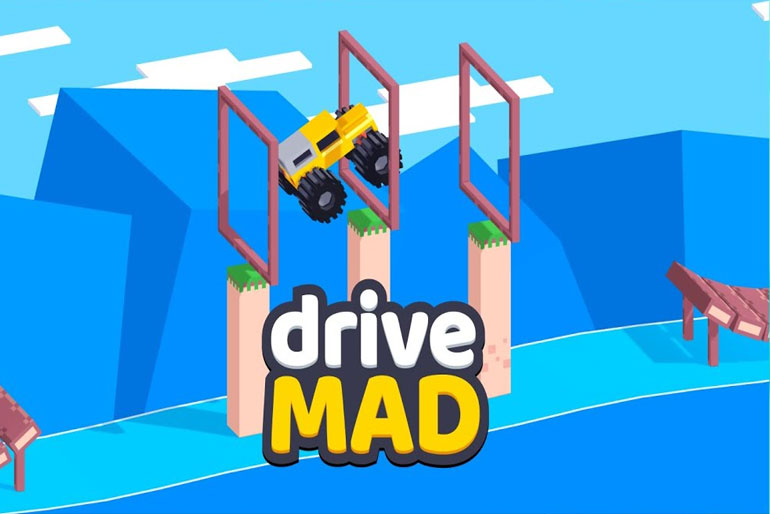Scroll through any popular casual‑game site today, and you’ll probably run into a chunky yellow pickup bouncing across rickety bridges. That toy‑like truck is the star of Drive Mad, a physics driving game that has quietly turned into an internet obsession. Players love its two‑button controls, goofy vehicles, and the outrageous stunts it dares you to pull off to reach the checkered flag. It’s quick, it’s tough, and it’s surprisingly deep for something that loads in seconds on almost any device.
Who built this thing?
The creative brain behind Drive Mad is Swedish indie developer Martin Magni, best known for the puzzle hit Mekorama and the build‑your‑own‑games sandbox Fancade. Magni first released Drive Mad inside Fancade as a bite‑sized demo of what the in‑app editor could do. Fans pushed it to the top of Fancade’s charts, so he broke it out into its own web and mobile releases. Today, the game counts hundreds of millions of plays across Coolmath Games, Poki, and the app stores—still handled by a one‑person studio.
The core idea: go fast, stay upright, don’t steer
Most driving games ask you to juggle steering, braking, gears, and drifting. Drive Mad strips all that away. Hold the right arrow (or tap the right side of your screen) to accelerate and the left arrow to brake or reverse. There’s no steering wheel; the car’s path is fixed. The challenge comes from a lively physics engine that treats every vehicle like a spring‑loaded toy. Land a little crooked, and the suspension can catapult you into a flip. Tap the brake too hard on a slope, and you might tip backward like a turtle on its shell. Learning to nurse the throttle and use momentum is the heart of the fun.
A box of toy cars
Early levels hand you a standard pickup, but later stages swap in all kinds of odd rides: monster‑truck wheels, snowplows, flimsy trailers, even a stretch limo. Each vehicle has its own weight and balance, forcing you to adjust your approach on the fly. The “Square Wheels” stage, for instance, gives you a cube on axles, turning every inch of road into a hopping contest. Variety keeps frustration down; when one design drives you crazy, the next often feels fresh and silly enough to keep you laughing.
Level design that teaches by surprise
Drive Mad’s stage list has grown from the original 100 to more than 200 handcrafted obstacle courses. A rope bridge sways under your tires, an icy ramp demands gentle throttle control, or a pile of blocks must be shoved aside without rolling over. There are no text tutorials—just instant restarts that let you experiment within seconds. That fast loop taps the same “one more try” compulsion that makes games like Super Meat Boy so sticky.
Accessibility first: tiny download, big reach
Magni keeps the file size under 20 MB—lighter than many sticker packs. The game runs offline once installed, yet it also plays smoothly in a browser tab on a school Chromebook or a phone with spotty data. Students sneak in quick races during study hall, and families fire it up on shared tablets without hogging storage.
Why everyone is talking about it
- Low barrier to entry. Two buttons mean anyone—grandparents, little kids, touch‑screen novices—can jump in.
- Hilarious physics. Watching your truck pogo‑stick after a bad landing is funny, not punishing. Failure is entertainment.
- Instant restarts. Crash, tap, you’re back at the start line. No load screens, no waiting.
- Fresh challenges. New level packs arrive every few months, and community remixes built inside Fancade give dedicated players endless bonus content.
A speedrunning darling
Because each stage lasts mere seconds once mastered, Drive Mad has become fertile ground for speedrunners. Speedrun.com hosts leaderboards for all 200 levels, with records measured in hundredths of a second. Competitors trade frame‑perfect throttle taps and dissect replays on Discord, shaving off milliseconds. Hunting a personal best on a single track is a gentle way to step into the broader speedrunning hobby.
Tips for first‑time drivers
- Feather the gas. Full throttle often flips you. Pulse the pedal to keep your nose down.
- Brake in the air. A tap mid‑jump tilts the car forward—handy when you’re about to land rear‑first.
- Use obstacles as ramps. Boxes and boulders can be launchpads, skipping tricky ground sections.
- Watch the suspension. Let the shocks settle before accelerating again to avoid wheelies.
- Memorize rhythms. Each level has a beat; after a few tries, you’ll sense when to pulse gas or brake.
The community vibe
Although Drive Mad has no multiplayer mode, the fan base is lively. Reddit threads dissect nasty stages like “Torque” and “Death Spiral” and share GIFs of improbable saves. TikTok clips break down how to land on a single tire to bypass a swinging hammer. Fancade’s editor lets players clone and remix levels, so creators upload custom gauntlets that crank the difficulty to absurd heights.
Behind the curtain: how physics makes the drama
The engine simulates torque, weight transfer, and friction, yet stays light enough to run on low‑end phones. Each wheel is modeled separately, giving that satisfying rubber‑band bounce when a tire compresses. The center of gravity sits deliberately high, exaggerating every tilt and flip—chaos you can still tame with skill. Because outcomes are deterministic, speedrunners can replicate tricks once they master the timing.
Recent updates and what’s coming next
The July 2025 patch rolled out a cleaner menu, achievements, and smoother frame pacing on older Android devices. Magni has hinted that “micro‑cars” and night stages with headlights are in the works. Community testers also report experimental wind tunnels that could change how classic tracks feel.
Learning through failure—why the design feels fair
Drive Mad’s instant‑retry loop creates a “low cost of failure.” You crash, laugh, and restart in a blink, which encourages experimentation. Some teachers even use the browser version during science units on force and motion: students record a stunt, then label where kinetic energy peaks or friction drops. Because the controls are so intuitive, class time shifts from explaining buttons to discussing physics.
Fancade, mods, and spin‑offs
Fancade’s drag‑and‑drop editor fuels an expanding universe of fan creations. Players duplicate official tracks and tweak gravity, wheel size, or terrain to invent brand‑new challenges. Some of these community packs go viral, inspiring informal “Drive Mad 2” playlists on YouTube and Poki. Everything uses the same chunky voxel art, so even wild mods—like gravity that flips every three seconds—still feel at home.
Comparisons with other physics racers
Fans often liken Drive Mad to Hill Climb Racing or Flash Relic Happy Wheels. They share rag‑doll chaos, but Drive Mad’s fixed forward drive makes it more of a rolling puzzle than a sandbox of accidents. There are no upgrades or currencies to grind; progress comes purely from skill.
Monetization without the grind
On mobile, Drive Mad is free with optional ads. Sessions are interrupted less often than in many hyper‑casual titles, and one small purchase removes ads entirely. By resisting aggressive monetization, Magni keeps trust high with parents and schools and ensures leaderboards reflect practice, not deep pockets.
A few advanced tricks
- Reverse bunny hop. Tap the brake, then accelerate on flat ground; stored suspension energy pops the nose up, letting you clear short spikes.
- Pivot roll. If the back wheels land first on a ramp edge, hold gas and the car will roll forward around its rear axle, turning a near‑crash into a smooth touchdown.
- Weight transfer jump. In heavy vehicles like the tank, pulse the throttle twice before a gap—the first pulse compresses shocks, the second launches the chassis outward.
Final thoughts
Drive Mad thrives on contradiction: it looks childish yet demands finesse, feels chaotic yet rewards planning, launches you skyward for laughs yet sneaks in real lessons about motion. It proves that a solo creator with sharp design and cross‑platform tech can grab a global audience without a blockbuster budget. When big‑budget racers chase realism, Drive Mad wins hearts with a boxy truck tumbling through cartoon moonscapes—and reminds us that laughter and discovery are the best prizes in gaming.
If you’re up for a snack‑sized challenge that runs on almost anything, fire up a browser or hit your app store and give Drive Mad a spin. Just don’t be surprised if “one quick run” turns into an hour of grinning retries. Remember: tap, crash, laugh, retry—few feelings beat nailing that perfect flip across a collapsing bridge.







